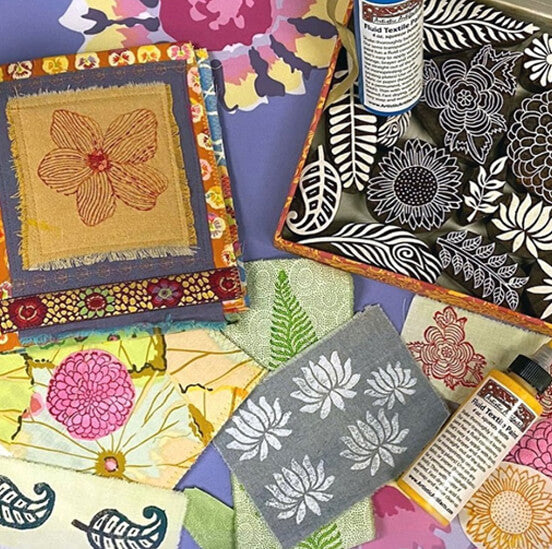Paper Piecing Aussie Blocks
Click for a larger view of Judy Gula’s completed quilt above »
I can still remember when Bonnie K. Hunter spoke at my local quilt guild, the Burke chapter of Quilter’s Unlimited* of Northern Virginia. I loved her quilt samples, patterns and fabric choices. Are you surprised? I have a very eclectic task in fabrics, from vintage to contemporary to ethnic. Bonnie hit the upcycle/repurpose interest that I have by using fabric salvaged from old clothing in her quilts. We do a lot of repurposing of items at Artistic Artifacts, especially me!
After hearing Bonnie talk, the very next day I ordered her book: Scraps & Shirttails: Reuse, Re-purpose, Recycle! The Art of “Quilting Green.”
Fast Forward several years, and I finally acquired enough scraps of Australian Aborigine designed fabric to try my hand at string/paper piecing. I wanted to illustrate the point that many traditional quilt patterns are perfect for our ethnic fabrics, including batiks and Australian.
Paper piecing? I had no clue how to do it... I just knew that needed I print out the template in Bonnie’s book. I chose her Virginia Strings block...her book notes that this is traditionally knows as the Rocky Road to Kansas but because she pieced her quilt while she was here in Northern Virginia for a week teaching, and backed it with a bargain purchase of University of Virgina fabric, she was inspired to name her quilt Virginia Bound.
I printed enough copies of the quarter block templates to create six blocks in total … I already knew that I would not be creating a full size quilt top. I pieced a couple of blocks and brought them, my book, tools and scraps (along with a couple other projects) to my chapter’s annual quilt retreat in order to get “in-person” training. Lucky for me, a fellow Burke member at the retreat had already used this block and offered some advice:
- Make your stitches short in order to make pulling the paper off easier. I can tell you that this step makes a big difference! Bonnie also offers this advice in her books and on her blog; she has a number of free patterns and tutorials available, such as this Flying Geese quilt.
- Create your block somewhat larger than you want it, and cut it down with a square template. I was creating 8" squares and used my 8½" square, my rotating cutting mat and jumbo Havel’s Rotary cutter to do the trimming.
So here we go. I think that Bonnie advises that you begin at the other end — for some reason I began with the smaller part of the kite shape. To help me while sewing, I did fold my template along the lines. Others will trace over the lines with a Sharpie to make them bolder, if they don’t show through to the back of the paper.
Keep piecing, by sewing right sides of fabric strips together, then flipping the last one added back down so that the right side of the fabric is facing up.
Below, I am beginning to strip piece the sides of the quarter block, using lighter fabrics so that the final block design will show.
Using my 8½" square ruler to trim the block from the back.
The front of my trimmed square! Leaving aside the fact that my photo turned out a bit blurry, it looked pretty good to me, so I made a few more.
I decided to keep going...after all, it wasn’t like I was going to run out of fabric!
Edited: My original post ended: “Below, my quilt top as of now. I do have to say that I am happy with how this has turned out. Will I create additional blocks? I am not sure yet. I might just finish this up with a border and stitching.” As you can see from the image at the top of this edited post, yes, I DID finish it up! See my post Quilting with a Walking Foot for additional details.
My challenge to you is to take a favorite “traditional” quilt pattern and use non traditional fabrics! Send us your photographs, whether a completed quilt, top, or pieced blocks, and we will share them on our blog.
* I’m proud to say I’m teaching at the upcoming 42nd Annual Quilter's Unlimited Quilt Show in Chantilly, VA, May 28-31, joining Jane Dávila, Dominique Ehrmann, Gyleen Fitzgerald, and Cyndi Souder with an exciting lineup of classes suitable for all levels of expertise. Many people travel to our show every year, as it (rightfully) has a reputation as one of the best on the East Coast. Come join us!

















Leave a comment